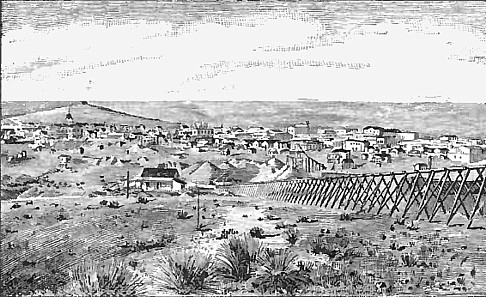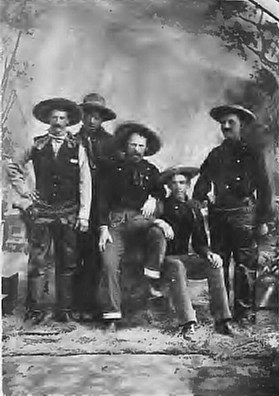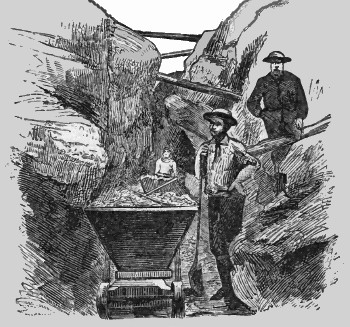The fame of Arizona’s mines of native gold, silver and copper has spread over all the world, but it is doubtful if ever those who have looked into the subject with some degree of attention realize how exhaustless her wealth, in this respect, is, or how fabulously rich her deposits of those minerals are. Notwithstanding the immense amount which has been already exported in the form of ore, or bullion, there is no exaggeration in saying that only a beginning has been made, and that, with increased facilities of transportation, improved appliances, and the introduction of additional capital for investment in mining and prospecting, developments will yet be made that will astonish the whole world, and raise Arizona to the undisputed position of the premier gold and silver mining country of the earth.
When Coronado and his companions were traversing Pimeria Alta (as Arizona, south of the Gila River, was then called) and passing over the northern plateau, in their wild goose chase after the "Seven Cities of Cibola," they little thought that they were treading on soil and crossing mountains which contained greater wealth, for the taking, than ever their wildest dreams had pictured, or the romancers, who told of the treasures of the Moqui Cities, had ever conceived of. Yet such was literally the case.
The Jesuit missionaries were wiser in their generation. They were the first to realize the mineral wealth of the country, and to set to work to secure it. Judging from the extensive traces of their workings around the old Missions, those holy fathers did not pass much of their time in idleness, however much of it they may have devoted to prayer, the conversion of the Pimas, and their subsequent instruction as Papagos.
There is abundant evidence that they impressed upon their converts the eminently practical view of religion, that "faith without works is dead," and the Indian, while he learned to be an expert miner, according to the primitive methods of those days, greatly enriched his ghostly advisers, by the output of the mines in which he toiled.
Others, besides the Mission Fathers, worked in the veins of Pimeria Alta, and took out much valuable silver ore; and soon the fame of the district spread over the whole world. The appliances for working the ore were, indeed, of the very rudest kind, but then the ore was of the very easiest description to reduce, much of it being virgin silver. Nuggets of the pure metal were found, varying from 200 to 2,700 lbs. in weight.
So long as Spanish rule came from Mexico, mining prospered amazingly in Arizona, but when the war for Mexican independence broke out, the industry got a serious set-back; and, afterwards, so long as the country remained under Mexican rule, there was no noticeable revival of the industry, operations finally ceasing altogether. The chief cause of this was that the Mexican government took no trouble to protect the miners from the raids of the murderous Apaches, and it was impossible to carry on that, or any other, industry, so long as those fiends were subjected to no effective restraint. The aspect of affairs changed, as indicated in the preceding articles, when Charles D. Poston organized two companies to work the mines in the Santa Ritas. In the face of many, and apparently insurmountable, obstacles and difficulties, those companies carried on their operations bravely, taking up the work at the point where the Mission Fathers had dropped it, and they did so with marked success. With Tubac as their central point, they built reduction works at Santa Rita, Sopori and Arivaca, and prospected and mined in all directions.
The breaking out of the Civil War, however, put an end to all this prosperity and promise of success. The withdrawal of the United States troops virtually threw the country back into the defenseless condition in which it was during the Mexican regime, and the bloodthirsty Apaches resumed their work of devastation and death. Outlaw bands, too, from Mexico, ably seconded the raids x>f the Indians, and everything had to be abandoned even the town of Tubac and the fugitives had to seek shelter in Tucson to escape being massacred. The events which succeeded, and which effectually stopped all mining in Arizona for two years, have been narrated elsewhere. In 1862 Pauline Weaver discovered placer gold near La Paz, on the Colorado, Northern Arizona, and a rush was made to the new El Dorado. A year later the same man discovered what are still known as the Weaver Mines in Yavapai County, and, soon after, the great find at Antelope Peak was made. These discoveries, of course, attracted miners by the thousand to Yavapai and Mohave counties, and an unexampled period of mining prosperity began in Northern Arizona, for the ledges and placers were abundant, easily worked, and rich beyond all precedent.
There were, of course, all sorts of difficulties to be encountered, obstacles to be overcome, and hardships to be endured. The chief difficulty was that of procuring supplies, owing to the remoteness of the mines from civilization, and the absence of roads; the principal obstacle was the treacherous and murderous Apache, who was ever on the alert to pick off his victim; and the hardships, though less trying than in other mining countries, not blessed with such a genial climate, were yet such as none but the most hardy and resolute would care to face in that remote wilderness.
Fortunately for the miners, the Apaches were placed on reservations in 1874, and their country thrown open to the prospector, who soon discovered the famous mines known as "The Globe" and "The Silver King," the report of which "finds" brought many thousand more miners into the country. The discovery of Tombstone added immensely to the silver rush excitement, and the superiority of Arizona as a mining country, over all others, which was then universally conceded, is still maintained unquestioned, and the lead she then took is altogether certain, not only to be maintained, but immensely increased as the march of development proceeds.
Return
to The Arizona Page:
Arizona Gold Rush Mining History




